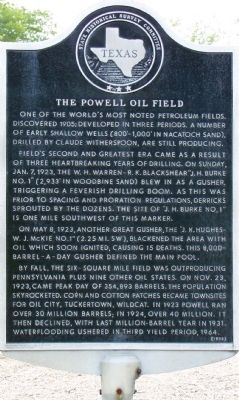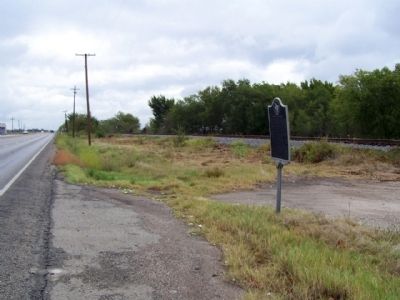Powell in Navarro County, Texas — The American South (West South Central)
The Powell Oil Field
Marker in memory of Mr. and Mrs. J. H. Burke and W. H. Warren sponsored by Mr. and Mrs. Paul J. Sloan
Erected 1973 by State Historical Survey Committee. (Marker Number 11624.)
Topics. This historical marker is listed in this topic list: Industry & Commerce. A significant historical date for this entry is May 8, 1923.
Location. 32° 7.047′ N, 96° 19.58′ W. Marker is in Powell, Texas, in Navarro County. Marker is on 1st Street (State Highway 31) near Carr Street, on the right when traveling east. Touch for map. Marker is in this post office area: Powell TX 75153, United States of America. Touch for directions.
Other nearby markers. At least 8 other markers are within 9 miles of this marker, measured as the crow flies. Air Activities of Texas Corsicana Field (approx. 7˝ miles away); Corsicana Newspapers (approx. 8.1 miles away); James Emerson Whiteselle (approx. 8.1 miles away); From Steam to Electric Rail (approx. 8.2 miles away); The Molloy Hotel (approx. 8.2 miles away); Capt. Charles Henry Allyn (approx. 8.2 miles away); Navarro County (approx. 8.2 miles away); Site of Merchants Opera House (approx. 8.2 miles away).
Regarding The Powell Oil Field. Encouraged by nearby discoveries in Mexia and Wortham, the Corsicana Deep Well Company announced plans to drill for oil in the Powell area in the June 9, 1919 issue of the Corsicana Daily Sun. However the drilling effort yielded a dry hole and was abandoned six months later.
A second attempt also failed. Finally, on January 7, 1923, now more than three years from the announcement, oil was found.
By July 14, 17 wells were in operation. Seven more came in on a single day, August 1, 1923. Soon the Powell field was pumping more oil than the combined oil production of the day in the states of Colorado, Illinois, Iowa, Kansas, Kentucky, New York, Ohio, Pennsylvania, Tennessee, and West Virginia.
The Powell oil field produced wealth and tragedy in great proportions. On May 10, 1923, a spark ignited the derrick floor. The fire caused 13 men to die from horrible burns.
At peak production the Powell field boasted more than 500 pumping wells and produced some 354,000 barrels (56,300 m3) of oil per day.
By the late 1920s the Powell field had been pumped dry and was abandoned. (Wikipedia)
Additional commentary.
1. Waterflooding
[Enhanced Oil Recovery, Well Completions]
A method of secondary recovery in which water is injected into the reservoir formation to displace residual oil. The water from injection wells physically sweeps the displaced oil to adjacent production wells. Potential problems associated with waterflood techniques include inefficient recovery due to variable permeability, or similar conditions affecting fluid transport
within the reservoir, and early water breakthrough that may cause production and surface processing problems.
— Submitted September 28, 2012, by Mike Stroud of Bluffton, South Carolina.
Credits. This page was last revised on June 16, 2016. It was originally submitted on September 23, 2012, by Mike Stroud of Bluffton, South Carolina. This page has been viewed 814 times since then and 100 times this year. Photos: 1, 2, 3. submitted on September 28, 2012, by Mike Stroud of Bluffton, South Carolina.


